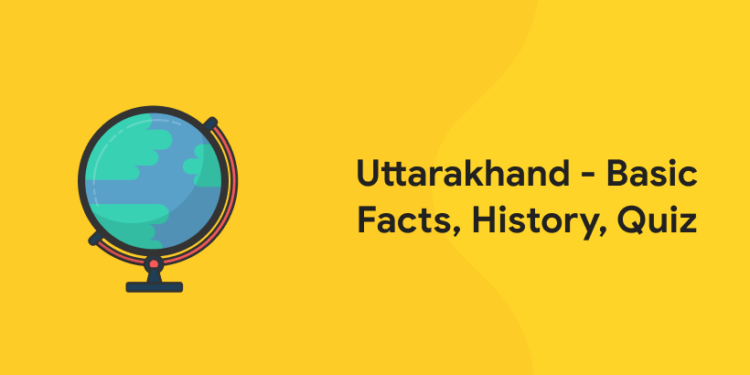Table of Contents
Uttarakhand, formerly known as Uttaranchal, is an Indian state, located in the northwestern part of the country. The winter capital of Uttarakhand is the northwestern city of DehraDun, the largest city of the state, which is a railhead and the summer capital is Gairsain, a town in Chamoli district. It is bordered to the northwest by the Indian state of Himachal Pradesh, to the northeast by the Tibet Autonomous Region of China, to the southeast by Nepal, and to the south and southwest by the Indian state of Uttar Pradesh.
The word meaning of uttarakhand is Uttara means ‘North’ and Khaṇḍa means ‘Land’, So Uttarakhand mean Northern Land. It is often referred as the “Devbhumi” (means “Land of the Gods”) due to its religious significance and numerous Hindu temples and pilgrimage centres found throughout the state.
History of Uttarakhand
The state of Uttaranchal is the 27th state of India and it was carved out of Uttar Pradesh on November 9, 2000 and in January 2007 the new state changed its name to Uttarakhand, meaning “northern region,” which was the traditional name for the area. The state covers an area of 19,739 square miles (51,125 square km) and Population is 10,116,752 since (2011). The state is divided into two divisions, Garhwal and Kumaon, with a total of 13 districts. Garhwal consists of 7 districts and Kumaon consists of 6 districts.The official language of Uttarakhand is Hindi, which is spoken natively by 43% of the population. Additionally, the classical language Sanskrit has been declared as the second official language.
Uttarakhand has a total area of 53,566 km2 (20,682 sq mi),of which 86% is mountainous and 65% is covered by forest.Most of the northern part of the state is covered by high Himalayan peaks and glaciers. In the first half of the nineteenth century, the expanding development of Indian roads, railways and other physical infrastructure was giving rise to concerns over indiscriminate logging, particularly in the Himalaya. Two of the most important rivers in Hinduism originate in the glaciers of Uttarakhand, the Ganges at Gangotri and the Yamuna at Yamunotri. They are fed by myriad lakes, glacial melts and streams.These two along with Badrinath and Kedarnath from the Chota Char Dham, a holy pilgrimage for the Hindus.
Uttarakhand can be divided into several physiographic zones, all running parallel to each other from northwest to southeast. The northern zone, popularly known as the Himadri, contains segments of the Zaskar and the Great Himalaya ranges, with elevations ranging roughly from 10,000 to 25,000 feet (3,000 to 7,600 metres). Most of the major peaks are located in this zone. Adjacent to and south of the Great Himalayas is a zone containing the Lesser Himalayas, known popularly as the Himachal, with elevations between about 6,500 and 10,000 feet (2,000 to 3,000 metres); the zone has two linear ranges—the Mussoorie and the Nag Tibba. To the south of the Himachal is a stretch of the Siwalik Range. The entire area containing the Himadri, the Himachal, and the Siwaliks is broadly known as the Kumaun Himalayas.
Uttarakhand has a highly varied topography, with snow-covered peaks, glaciers, deep canyons, roaring streams, beautiful lakes, and a few patches of dusty plains in the south. Some of the highest mountains in the world are found in Uttarakhand. These include Nanda Devi (25,646 feet), which is the second highest peak in India, Kamet (25,446 feet), and Badrinath (23,420 feet).
Basic Facts about Uttarakhand
1: Who was the first woman President of India?
- The High Court of the state is located in Nainital.
- The winter capital of Uttarakhand in Dehradun and the summer is Gairsain
- Present Chief Minister of Uttarakhand is Pushkar Singh Dami.
- Gurmit Singh is the Present governor of Uttarakhand.
- Official languages of the state are Hindi and Sanskrit.
- Formed on November 9, 2000 and changed its name in January 2007.
- The state has two divisions including 13 districts, named as Garhwal and Kumaon.
- Uttarakhand has 5 Lok Sabha seats and 3 Raj Sabha seats.
- Ganges at Gangotri and Yamuna at Yamunotri are the two famous rivers originating from Uttarakhand.
- Alpine Musk deer is the National Animal and Himalayan monal is the National Bird of Uttarakhand
- National Sports of the state Uttarakhand is Football.
Free UPSKILLING Courses!
Take your first step toward mastering in-demand skills, acing interviews, and securing top-tier jobs with Entri's free upskilling courses.
Start Learning!GK Quiz on Uttarakhand
Q.1.When was Uttaranchal carved out of Uttar Pradesh?
Answer: November 9, 2000
Q.2.which is the official language of Uttarakhand?
Answer: Hindi
Q.3.In which year Uttaranchal was renamed as Uttarakhand?
Answer: 1 January 2007
Q.4.What is the Total Area of Uttarakhand?
Answer: 53,483 km.sq
Q.5.Who was the first Chief Minister of Uttarakhand?
Answer: Nityanand Swami
Q.6.Who was the First Governor of Uttarakhand?
Answer: Surjit Singh Barnala
Q.7.Besides Hindi, which is the official language of uttarakhand?
Answer: Sanskrit
Q.8.Winter capital of the state Uttarakhand is ________.
Answer: Dehradun
Q.9.Which is the 27th State of India?
Answer: Uttarakhand
Q.10.What is the Total Area of Uttarakhand?
Answer: 53,483 km2
Q.11.Where is the Judicial Capital of Uttarakhand?
Answer: Nainital
Q.12.How many Rajya Sabha Seats does Uttarakhand have?
Answer: 3 Seats
Q.13.How many Lok Sabha Seats does Uttarakhand have?
Answer: 5 Seats
Q.14.How many MLAs are in the Uttarakhand Legislative Assembly?
Answer: 70 members
Q.15.How many Districts are in Uttarakhand?
Answer: 13 (Thirteen)
Q.16. Which is the largest District of Uttarakhand?
Answer: Chamoli (8,030km2)
Q.17.How many Divisions are there in Uttarakhand?
Answer: Two
Q.18.Which are the two Divisions of Uttarakhand?
Answer: Garhwal and Kumaon
Q.19.Which are the two most important rivers in Hinduism that originate from the glaciers of Uttarakhand?
Answer: Ganges at Gangotri and Yamuna at Yamunotri
Q.20.How many National Parks are in Uttarakhand?
Answer: 6 National Parks













